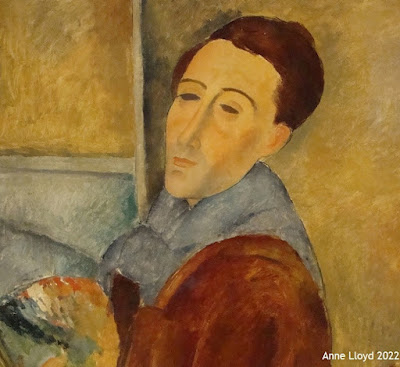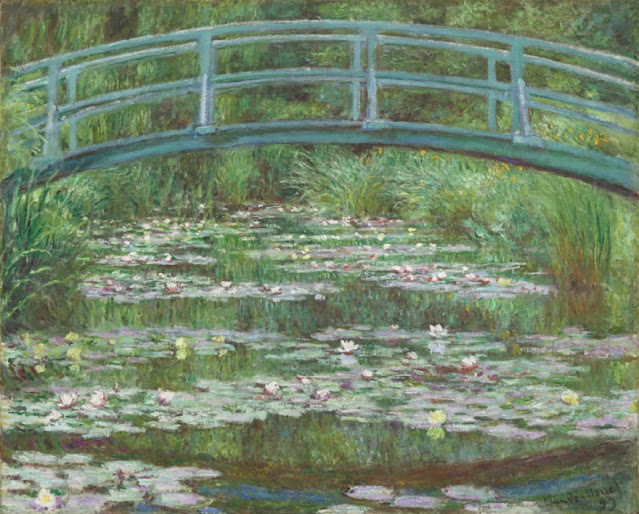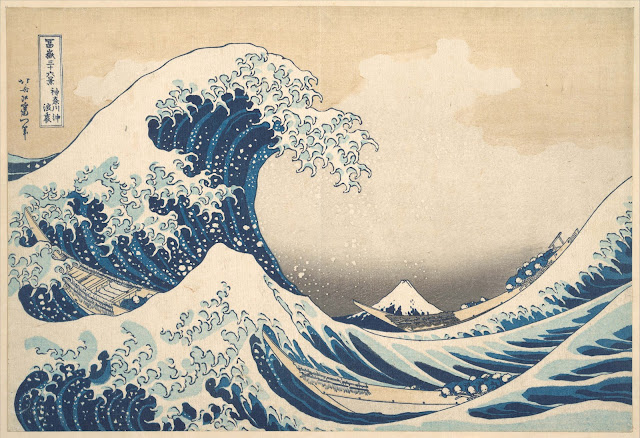Modigliani Up Close
Reviewed by Ed Voves
Original Photography by Anne Lloyd
Modigliani Up Close, the title of the new exhibit at the Barnes Foundation, was aptly chosen. The very fiber of Modigliani's art, the chisel marks of his sculpting tools on limestone blocks, the brush strokes of his controversial paintings - these comprise the subject matter of this fascinating Barnes exhibition.
As a result of such intimate study, our perception of Amedeo Modigliani (1884-1920) shifts from regarding him as a doomed, self-destructive victim of his own excesses to a more balanced appraisal. Modigliani was one of the greatest figurative artists, in stone and paint, of the twentieth century. In a decade and a half of prodigious effort, he joined in shifting the trajectory of modern art while maintaining its human face.
Art lovers who relish the harrowing details of the lives of "tragic" artists may - at first - be disappointed with the theme of the Barnes exhibition. Examining the art of Modigliani with few digressions about his personal life is seemingly to ignore a compelling part of his story. Modigliani certainly was one of art history's great "hell-raisers" - though hardly in the same league with Caravaggio or Jackson Pollock.
The great "tragedy" of Modigliani is the mystery of how he so quickly adapted his classical art training to the radical innovations of Modernism. There is so much we don't know about the young Modigliani. Many of his early works have not survived. Short of cash, Modigliani frequently abandoned art works when he slipped out of his studio/living quarters because he could not pay the rent.
When Modigliani arrived in Paris in 1906, he identified himself as a sculptor. It was a surprising declaration. He had no systematic training in sculpting as a student in Italy. Indeed, there is little evidence of Modigliani investigating and copying any of the great masters of art, except for Cezanne.
Yet, Modigliani quickly demonstrated his ability as a portrait painter after arriving in Paris. Even more dramatically, in October 1912, at the Salon d' Automne, seven of his carved stone heads were prominently displayed. Where did Modigliani find the creative spark for these sensational works of art? How had this stunning transformation occurred?
Modigliani was fortunate in finding an enthusiastic supporter, Dr. Paul Alexandre, during his early years in Paris. Alexandre, at Modigliani's request, supplied an introduction to the Romanian sculptor, Constantin Brancusi. This evolved into a key relationship from the standpoint of artistic development. Brancusi taught Modigliani the basics of carving and his example as an independent sculptor was huge.
Modigliani's sculptures and paintings are so unique, however, that no single source can have supplied the impetus for the creative revolution which led him to create these incomparable works of art. Scholars of Modigliani's work rightly note the influence of African art, so important for many of the artists of his era. But there is so much more to consider.
One of the intriguing theories about Modigliani's sculptures is that he created these enigmatic stone heads with a group presentation in mind. There are stories of him placing candles on top of some of these heads. The Barnes exhibit catalog entry for the Head of a Woman (1912) notes that "waxy surface accretions extend in long drips from the oblong area at the crown of the head down the proper-left side."
The effect of the flickering candles in Modigliani's darkened studio, according to Jacob Epstein, "was that of a primitive temple."
Such an unearthly scene is unlikely to ever take place in a museum. However, by some unintended trick of overhead lighting in the Barnes exhibit gallery, my wife Anne took a photo of Head of a Women which provides a sense of the numinous atmosphere in Modigliani's candle-lit studio.
If the Barnes curators refrained from lighting any candles, they did replicate the Salon d' Automne display with eight of Modigliani's sculpted heads. It is an extraordinary sight to behold.
Between 1909 and 1915, Modigliani carved twenty-three stone heads and two standing/crouching figures. Accurately dating these sculptures has bedeviled art scholars for decades. The earliest-presumed one is in the collection of Harvard's Fogg Museum. It is believed to have been created in 1911 and shows little influence of African art.
A 1910 painting, now in a private collection, likely served as a model for this stone head (also known as Head Vlll). The major difference between the painting and the sculpted head is that the latter is graced by an enigmatic smile.
This unearthly smile recalls the facial expression appearing on the kouros and kore statues of archaic-era Greece. With his training in classical art in Florence and Venice, Modigliani would have been familiar with these early Greek statues.
African and Oceanic art was all the rage in the avant-garde communities of Montmartre and Montparnasse. Modigliani enthusiastically joined in the celebration of "primitive" art.
The most finished areas of some of the heads, at the rear of the blocks, were the result of being polished by industrial tools - not by Modigliani's hand.
Modigliani secured these limestone blocks from Parisian construction workers, sometimes after sharing a bottle of brandy with them. On other occasions, he slipped into building sites under the cover of darkness and made-off with a block of stone. It was a fairly common practice.
As noted, the Barnes exhibition and the related catalog do not cover Modigliani's "bohemian" life style in any detail. Instead, very detailed analysis is devoted to his artistic techniques and the materials he used. If not a "page-turning" read, the catalog leaves no doubt about the dedication and zeal of Modigliani as he labored in carving limestone blocks into a body of sculpture that is both monumental and deeply moving.
Here is a sample of the catalog text, dealing with Head of a Woman (1911-12) in the Chester Dale Collection of the National Gallery of Art in Washington, D.C.
Known for his direct-carving method and impatience with clay modeling, Modigliani took advantage of limestone's excellent carving properties and employed a standard array of stone-carving tools... He likely began by roughing out the shape from the large mass of stone using a hammer and point chisel before switching to a flat chisel to delineate two shallow arcs - one for the top of the forehead, the other to define the extent of the top layer of hair.
Even with the intensity of his work ethic and increasing facility in carving, Modigliani could not sustain his vocation as a sculptor. By 1915, his already weakened lungs (from childhood ailments) were endangered by daily exposure to a barrage of limestone chips and dust particles. He switched back to painting and, in the four years of frenzied life remaining to him, produced the striking portraits and nudes which fill the galleries of the Barnes exhibition space.
As a portrait painter, Modigliani was daring and uncompromising.
In 1909, Dr. Alexandre secured a commission for "Modi" to paint an aristocratic woman, Baroness Marguerite de Hasse de Villiars, in her riding apparel. Modigliani refused his sitter's demand to depict her in a red English hunting jacket. Modigliani insisted that it be a golden-orange hue, which worked brilliantly against the dark, Velazquez-style background. Baroness de Hasse refused to pay for her portrait and the indulgent Alexandre bought it, now titled The Amazon.
As Modigliani's interest in African and Oceanic art deepened, he began to incorporate the insights he derived from these new and - for many - alarming sources into his portraits. We can readily see this transition in his 1915 portrait of the English writer, Beatrice Hastings.
Ironically bearing the title Madam Pompadour (an indication of their tempestuous relationship), the painting blends African mask-like treatment with Hastings' actual features.
Modigliani was often so hard-up for funds that he reused a canvas for a new portrait or painted on the back of one, as we see in Maud Abrantes (1908), painted on the verso of his unsettling Nude with a Hat.
The curatorial team of Modigliani Up Close scrutinizes Modigliani's paintings with the same exactitude as they did for the carved heads. Important consideration is given to Modigliani's switch to using a blue-gray base coat for his later paintings. The curators even count the average number of threads per .cm on the canvases of some of Modigliani's paintings (albeit in the footnotes).
For visitors to Modigliani Up Close, the results of the close-examination of Modigliani's works are displayed in numerous large format photos of the X-radiograph scans of his paintings. These are placed side-by-side with the originals. This allows for fascinating, comparative study of how Modigliani worked and revised his paintings.
Modigliani's reuse of canvases allowed him to scrap-off paint or leave it, depending on the kind of surface texture he wanted on the new painting. This can be seen by comparing the finished version of Portrait of a Girl (c. 1916-17), now in the Tate's collection, with the X-radiograph.
Along with the working revisions of Portrait of a Girl, the X-radiograph shows that an earlier portrait, almost certainly of Beatrice Hastings, which was painted over. Modigliani was certainly not a sentimentalist.
Nor was Modigliani coy about acknowledging his sexuality. The Barnes exhibition displays an impressive array of his nudes. These are among the most erotically-charged nudes in the canon of Western art.
Modigliani painted unclothed women in ways which definitely straddle the "nude/naked" categorization. But they are not pornographic by any standard, even in 1917. There was little to see that Manet or Courbet had not depicted decades earlier. The infamous closure of Modigliani's one exhibition on charges of public indecency was due mostly to the location of the Berthe Weil Gallery, where some of these nudes were on prominent display in the window. It was directly across the street from a police station!
As the Barnes exhibition text reveals, the age of sexual consent in France during the World War I years was thirteen. Modigliani, red-blooded male that he was, showed that he was aware of that stipulation. His sensitive portrait of a young-teen girl named Elvira is a tribute to her physical beauty and also to her legal status and her emotional well-being.
Moreover, Modigliani never painted any of the women in his life in the nude. He was respectful to Beatrice Hastings, despite public displays of anger, and the same was true of the last - and most tragic - love of his life, Jeanne Hébuterne.
The row of three-quarter length portraits of Jeanne Hébuterne is one of the highlights of the exhibition. In a demonstration of the true alchemy of art, Modigliani translated his love for Jeanne into incomparable, profoundly beautiful portraits. Part-Botticelli Madonna, part-tribal goddess, entirely a unique person in her own right! This was how Modigliani depicted the young woman who could not live without him.
After the disaster of the Bethe Weil Gallery exhibition, Modigliani went to the south of France to try and regain his health. The life force was draining from him, as his lungs gave way to the tuberculosis he had contracted as a boy.
This was a difficult period, in many ways, marked by the last bloody months of fighting of World War I, the pandemic of the Spanish influenza and the tense uncertainty that the November 11, 1918 Armistice would hold.
Modigliani responded to his dwindling health and the global tragedy by painting a moving series of portraits of anonymous young people.
I was particularly struck by the image of a young boy wearing a horizon-blue military tunic such as the troops of the French Army wore. As France scrapped the "bottom of the barrel" to find recruits to fill the depleted ranks of its army, was this pensive youth wondering if he would be called upon to fight the last battle of the War to End All Wars?
We will never know, but the important lesson of these final paintings of Modigliani's brief life was what he chose for his subject matter - hope rather than despair, not death but life.
Years before, in 1912, Modigliani joined with Jacob Epstein in a visionary plan to create a "temple of beauty" filled with their sculptures. It was, as we know to our sorrow, never built.
Some dreams, however, do not die. Modigliani Up Close, at the Barnes Foundation, has summoned Modigliani's dream back to life and made it real.
For the next few months, in Philadelphia, Amedeo Modigliani's Temple of Beauty will be on view for all to see.
***
Text: Copyright of Ed Voves. Original Photos: Anne Lloyd, All rights reserved
Introductory image: Anne Lloyd, Photo (2022) Amedeo Modigliani's Head, 1911-12. Limestone: 25 x 6 x 8 1/4 in, (63.5 x 15.2 x 21 cm.) Guggenheim Museum, 55.1421
Anne Lloyd, Photo (2022) Gallery view of Modigliani Up Close, showing Amedeo Modigliani's The Little Peasant, c. 1918, from the Tate Collection, London.
Anne Lloyd, Photo (2022) Amedeo Modigliani's Head of a Woman, 1912. Limestone: 28 1/2 x 6 5/16 x 9 1/2 in., (71.4 x 16 x 24.1 cm.) Philadelphia Museum of Art. Gift of Mrs. Maurice J. Speiser. # 1950-2-1
Anne Lloyd, Photo (2022) Modigliani Up Close at the Barnes Foundation, showing the sculpture gallery display of 8 carved heads by Amedeo Modigliani.
Anne Lloyd, Photo (2022) Gallery view of Modigliani Up Close at the Barnes Foundation, with Amedeo Modigliani's Head, c. 1911 in the foreground.
Anne Lloyd, Photo (2022) Amedeo Modigliani's Head, c. 1911. 15 1/2 x 12 1/4 x 7 3/8 in., (39.4 x 31.1 x 18.7 cm.) Fogg Museum – Harvard. #1992.254
Anne Lloyd, Photo (2022) Gallery view of the Modigliani Up Close exhibition. In the foreground is the Museum of Modern Art’s Head, c. 1915, by Amedeo Modigliani. Limestone: 22 1/4 x 5 x 14 3/4" (56.5 x 12.7 x 37.4 cm) Gift of Abby Aldrich Rockefeller in memory of Mrs. Cornelius J. Sullivan. #593.1939
Anne Lloyd, Photo (2022) Amedeo Modigliani's Head, 1911-12. Stone: 19 5/8 x 7 1/4 x 9 in. (49.5 x 18.4 x 22.8 cm) Hirshhorn Museum #66.3582
Anne Lloyd, Photo (2022) Profile view of Amedeo Modigliani's Head, c. 1915, from the MOMA collection.
Anne Lloyd, Photo (2022) Amedeo Modigliani's The Amazon, 1909. Oil on canvas: 36 1/4 x 25 9/16 inches (92 x 65 cm) Private collection.
Anne Lloyd, Photo (2022) Amedeo Modigliani's Madam Pompadour, 1915. Oil on canvas: 24 1/16 x 19 3/4 inches (61.1 x 50.2 cm) Art Institute of Chicago, Winterbotham Collection.
Anne Lloyd, Photo (2022) Amedeo Modigliani's Maud Abrantes (1908)
Anne Lloyd, Photo (2022) Gallery view of the Modigliani Up Close exhibition. Patron is comparing Modigliani's Jeanne Hébuterne, 1919, with an X-radiograph of the painting.
Anne Lloyd, Photo (2022) Amedeo Modigliani's Portrait of a Girl (c. 1916-17) Oil on canvas: 31 3/4 x 23 1/2 inches (80.6 x 59.7 cm) Tate Collection, London.
Anne Lloyd, Photo (2022) X-radiograph of Portrait of a Girl.
Anne Lloyd, Photo (2022) Gallery view of the Modigliani Up Close exhibition, showing Amedeo Modigliani's Reclining Nude, 1917, from the collection of the Metropolitan Museum of Art.
Anne Lloyd, Photo (2022) Amedeo Modigliani's Standing Nude (Elvira), c. 1918. Oil on Canvas: 36 1/4 x 23 5/8 in. (92 x 60 cm.) Kunstmuseum – Bern, Switzerland.
Anne Lloyd, Photo (2022) Gallery view of the Modigliani Up Close exhibition. Patron is examining Modigliani's Portrait of Jeanne Hébuterne, 1918.
Amedeo Modigliani Italian (1884-1920) Blue Eyes (Portrait of Madame Jeanne Hébuterne), 1917. Oil on canvas: 21 1/2 x 16 7/8 inches (54.6 x 42.9 cm) Philadelphia Museum of Art, The Samuel S. White 3rd and Vera White Collection, 1967. #1967-30-59
Anne Lloyd, Photo (2022) Detail of Amedeo Modigliani's Self-Portrait, 1919. Oil on canvas: 39 3/8 x 25 37/8 inches (100 x 64.5 cm) Museu of Art Contemporanea, Universidade de Sao Paulo.
Anne Lloyd, Photo (2022) Amedeo Modigliani's The Boy, c.1919. Oil on canvas: 36 1/4 x 23 3/4 inches (92.1 x 60.3 cm) Indianopolis Museum of Art, Gift of Mrs. Julian Bobbs in memory of Wiliam Ray Adams, 46.22
Anne Lloyd, Photo (2022) Amedeo Modigliani's Head, 1911-12, from the Guggenheim Museum collection.






























.jpg)



















